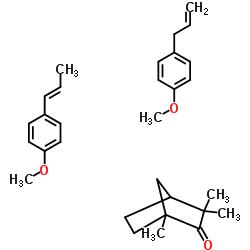小茴香油

小茴香油结构式

|
常用名 | 小茴香油 | 英文名 | Fennel oil |
|---|---|---|---|---|
| CAS号 | 8006-84-6 | 分子量 | 448.6368 | |
| 密度 | 0.963g/mLat 25°C | 沸点 | 227 °C(lit.) | |
| 分子式 | 2[C10H12O].C10H16O | 熔点 | 5 °C(lit.) | |
| MSDS | 中文版 美版 | 闪点 | 60℃ | |
| 符号 |


GHS02, GHS07 |
信号词 | Warning |
小茴香油用途1.主要用于酒类、糖果、饮料、面包、冰淇淋、胶姆糖、肉类、肉汤等中,小茴香籽可用作调味料、药材。其油主要用于调配牙膏、牙粉以及烟、酒、糖果用香精。在香水、化妆品香精中也少量使用。 |
| 中文名 | 茴香油 |
|---|---|
| 英文名 | Fennel oil |
| 中文别名 | 小茴香油 |
| 英文别名 | 更多 |
| 密度 | 0.963g/mLat 25°C |
|---|---|
| 沸点 | 227 °C(lit.) |
| 熔点 | 5 °C(lit.) |
| 分子式 | 2[C10H12O].C10H16O |
| 分子量 | 448.6368 |
| 闪点 | 60℃ |
| 外观性状 | 无色至黄色透明液体 |
| 储存条件 | 存放于阴凉、干燥处。 |
| 稳定性 | 无色或淡黄色液体,有小茴香(Foeniculum vulgare mill)气味,分为苦和甜两种。主要成分是大茴香脑,含量60%左右,其次是茴香酮和蒎烯等。 |
| 更多 | 1. 性状:浅黄色或黄绿色液体 2. 密度(g/mL 25ºC):0.963 3. 相对蒸汽密度(g/mL,空气=1):未确定 4. 熔点(ºC常压):5 5. 沸点(ºC,常压):227 6. 沸点(ºC,5.2kPa):未确定 7. 折射率(n20/D):1.538 8. 闪点(ºC,):140℉ 9. 比旋光度(º):未确定 10. 自燃点或引燃温度(ºC):未确定 11. 蒸气压(kPa,25ºC):未确定 12. 饱和蒸气压(kPa,60ºC):未确定 13. 燃烧热(KJ/mol):未确定 14. 临界温度(ºC):未确定 15. 临界压力(KPa):未确定 16. 油水(辛醇/水)分配系数的对数值(25℃):未确定 17. 爆炸上限(%,V/V):未确定 18. 爆炸下限(%,V/V):未确定 19. 溶解性(mg/mL) :微溶于水,可溶于乙醇和乙醚。 |
| 符号 |


GHS02, GHS07 |
|---|---|
| 信号词 | Warning |
| 危害声明 | H226-H315 |
| 个人防护装备 | Eyeshields;full-face respirator (US);Gloves;multi-purpose combination respirator cartridge (US);type ABEK (EN14387) respirator filter |
| 危害码 (欧洲) | Xi |
| 风险声明 (欧洲) | R38 |
| 危险品运输编码 | UN 1993 3/PG 3 |
| WGK德国 | 2 |
| RTECS号 | LJ2550000 |
| 包装等级 | III |
1.由伞形科多年生草本植物小茴香或称怀香(Foeniculum vulgare)的成熟果实经干燥、磨碎后经水蒸气蒸馏而得。得率约5.0%。主要产于法国、意大利等,我国甘肃等地亦产。
|
Biodegradable gelatin-chitosan films incorporated with essential oils as antimicrobial agents for fish preservation.
Food Microbiol. 27(7) , 889-96, (2010) Essential oils of clove (Syzygium aromaticum L.), fennel (Foeniculum vulgare Miller), cypress (Cupressus sempervirens L.), lavender (Lavandula angustifolia), thyme (Thymus vulgaris L.), herb-of-the-cr... |
|
|
Effects of essential oils from fennel (Foeniculi aetheroleum) and caraway (Carvi aetheroleum) in pigs.
J. Anim. Physiol. Anim. Nutr. (Berl.) 90(11-12) , 500-10, (2006) The ban of antibiotics as a feed additive requires alternatives to stabilize the health and performance particularly of the young animals. Essential oils obtained from fennel seed (Foeniculi aetherole... |
|
|
Fennel and anise as estrogenic agents.
J. Ethnopharmacol. 2(4) , 337-44, (1980) Fennel, Foeniculum vulgare, and anise, Pimpinella anisum, are plants which have been used as estrogenic agents for millennia. Specifically, they have been reputed to increase milk secretion, promote m... |
| MFCD00146918 |


